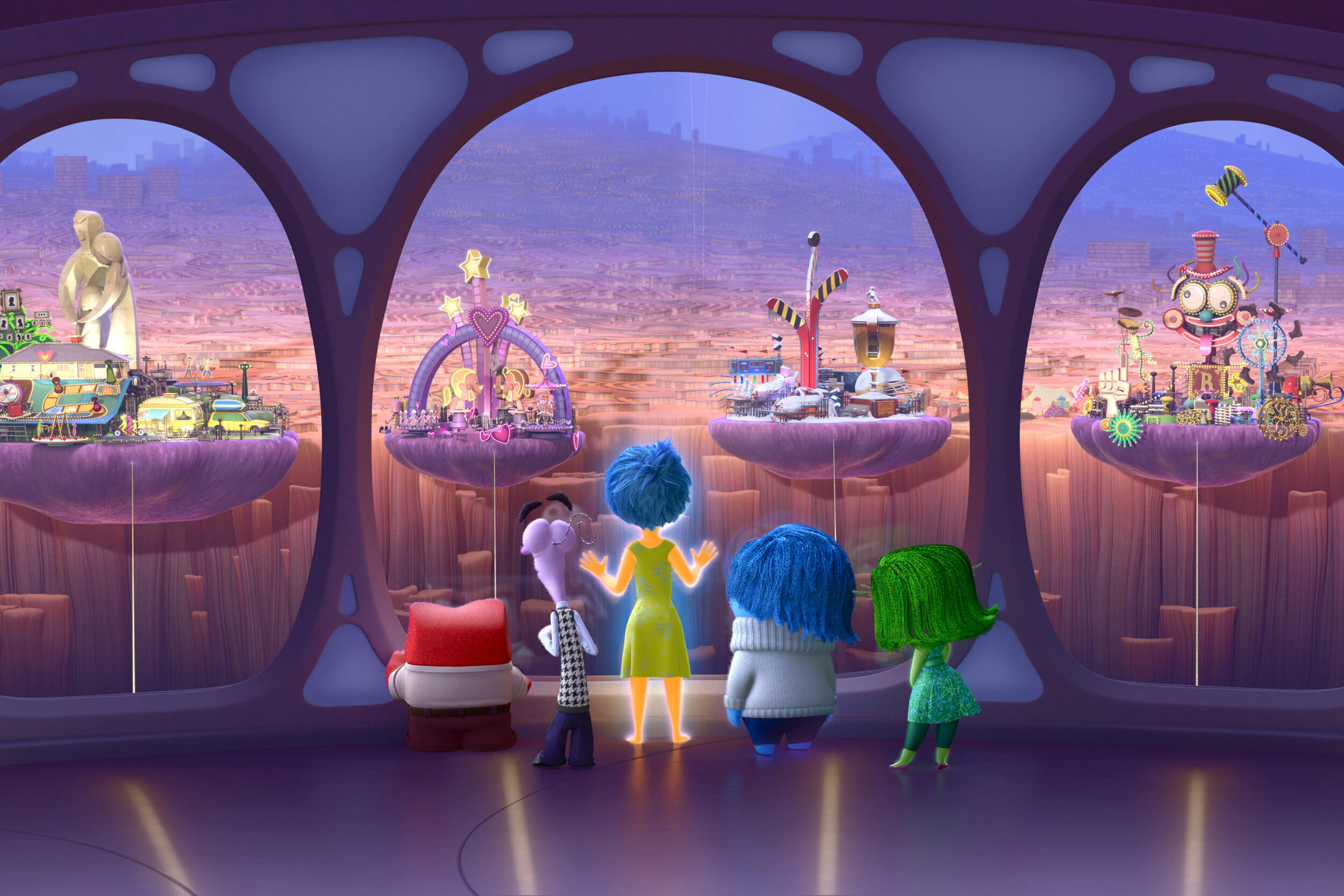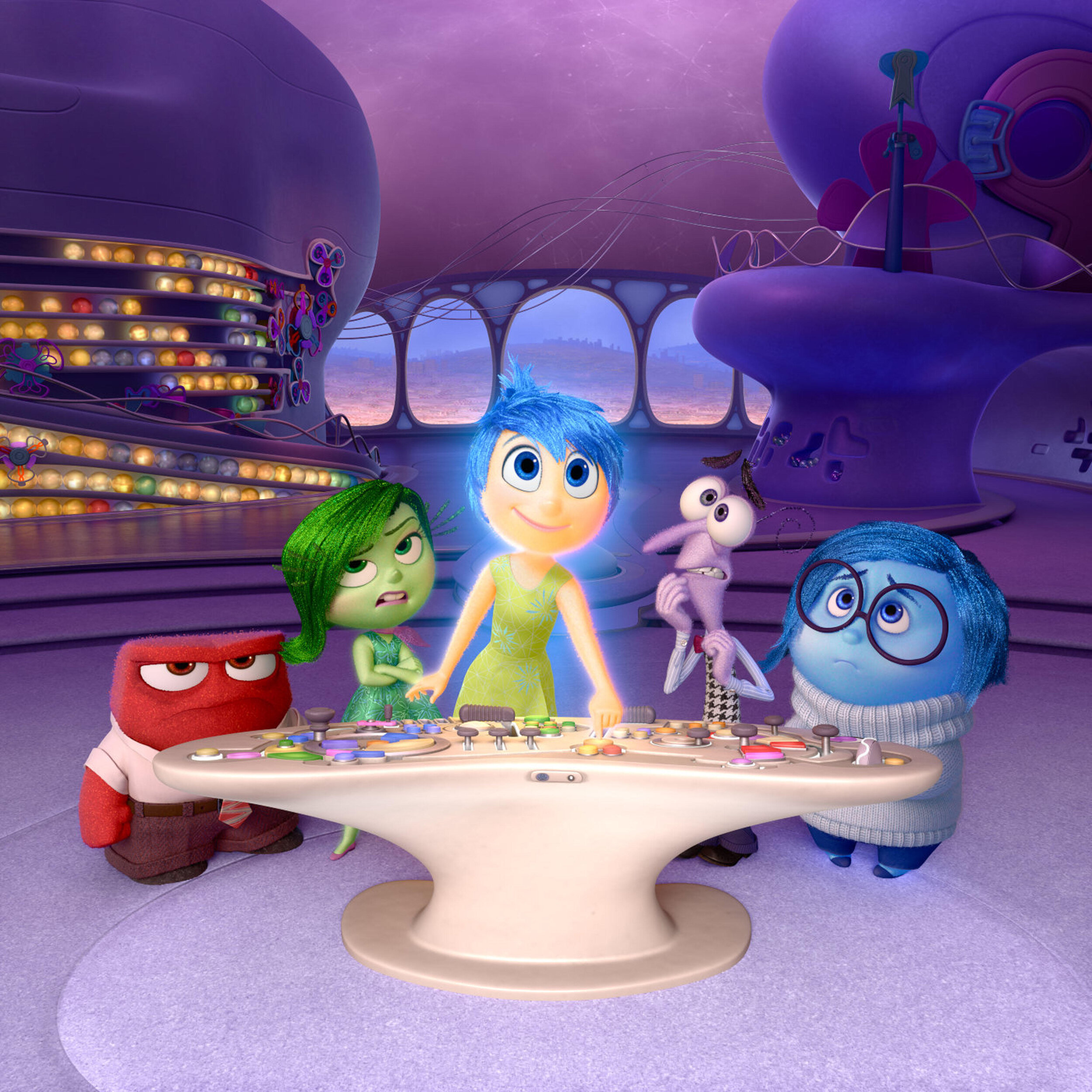INSIDE OUT: PINT-SIZED NEUROSCIENCE
Anger, Fear, Joy, Sadness and Disgust look out upon Riley's Islands of Personality in "Inside Out", 2015 Disney Photo credit: PictureLux
Despite neuroscience’s broad popular appeal across disciplines, it can be difficult to translate the neuroscientific mechanisms of personality into layman's terms. Imagine what the boardroom at Pixar must have felt like then when director Pete Docter wanted to set these complex neuroscientific concepts as the epicentre for a new children’s film: Inside Out. Not only would the film push neuroscience further into the popular fold, but it would do so by tackling stereotypes of emotional expression that had long since plagued both public discourse and academia.
As Graham et al. noted in their study, The Positives of Negative Emotions: ‘There is a substantial literature suggesting that people react negatively to others’ expressions of negative emotions’ (Graham et al., 2008). The idea that emotions should be suppressed has been a culturally accepted norm for generations, particularly within the construct of masculinity. Numerous studies have explored this junction of psychology and neuroscience in recent years (Berke et al., 2018). Of course, Docter’s idea to tackle neuroscience in a format fit for children didn’t just fall out of the sky. Speaking to The New York Times, Docter explained: ‘I always felt this awkwardness and shyness, and so I kind of retreated into my own little world… that’s part of why I gravitated toward animation. It was easier to draw something that expressed how I felt than to say it out loud.’
Docter’s introversion greatly affected his ability to assimilate in high school (something a fair number of us can relate to). However, it wasn’t until years later, when Docter saw his own daughter experiencing the same sort of social angst, that the concept of Inside Out was born. As many a father has done, he couldn’t help but wonder what was going on inside his daughter’s head. However, Docter was committed to maintaining the film’s scientific accuracy throughout. Two esteemed professors of psychology from the University of California, Paul Ekman and Dacher Keltner, were brought in as scientific consultants for the film. This ensured that the film’s core concepts of emotion, perception and memory were rooted in scientific principles.
INSIDE OUT, Riley (voice: Kaitlyn Dias), 2015. © Walt Disney Studios Motion Pictures / courtesy Everett Collection
Ekman’s research on facial expressions has been particularly influential, and controversial, for the field of affective neuroscience, which focuses on the study of emotions (Ekman, 1993). In his early years, Ekman rose to scientific fame after establishing the concept of six universal facial expressions of emotion: scaredness, joy, wrath, grossness, shock and loneliness (Ekman & Friesen, 1971). In the context of Inside Out, these six emotions were distilled down to five characters in Riley’s brain that constituted her aggregate personality: disgust, fear, joy, sadness and anger. Despite this rather simple and convenient conceptualization of emotional states, Ekman’s work has been challenged over the years by others in the field, and a growing body of scientific literature continues to reveal the neuroscientific complexity of personality (Gendron & Barrett, 2009). Indeed, more recent work by Northeastern University’s Lisa Barret highlights the importance of context for emotion perception (Barrett et al., 2011). A recent review authored by Kristen Lindquist and Maria Gendron further highlights research showing that language itself can influence how we perceive and interpret others’ facial expressions (Lindquist & Gendron, 2013).
Interestingly, earlier pitches for Inside Out saw the inclusion of additional emotional states, including pride, hope, ennui and even schadenfreude, the experience of pleasure from seeing others suffer or fail. Ultimately, given the target demographic for the film, it was probably a good call for Docter to skip these emotional influences on Riley’s actions, especially schadenfreude (if that appears to be a governing emotion in your child, it might be a good idea to have a sit down with them).
INSIDE OUT, 2015.
Photo credit: PIXAR ANIMATION STUDIOS/WALT DISNEY PICTURES / Album
Aside from the ongoing debate on emotional states, Ekman has long argued the necessity for emotional expression in developing and sustaining interpersonal relationships. Its importance was highlighted in the Handbook of Cognition and Emotion, with Ekman writing: ‘People I have studied who have congenital facial paralysis (Mobius syndrome) report great difficulty in developing and maintaining even casual relationships, since they have no capability for facial expressiveness’ (Dalgleish & Power, 2000). The consequences of not being able to display emotions are played out in the film’s narrative; the absence of Joy and Sadness from Riley’s control centre leaves her unable to communicate the extent of her depression to her parents. This results in an inappropriate response from them, further frustrating Riley and further confusing her parents.
As we later discover during the film’s final act, one of the cornerstones of Riley’s emotional construct is her love for playing hockey, particularly a memory of having missed the winning shot during a league game. In this ‘core memory,’ Riley’s expression of sadness over having lost the game sparks a positive response in her teammates, as they offer to cheer her up. This highlights the social importance of emotional perception. Although it is only touched upon briefly in the film, the dynamics of emotional expression between teammates is an entire field of research unto itself. Herman Tse and Marie Dasborough, writing in A Study of Exchange and Emotions in Team Member Relationships, note: ‘Individuals experience a variety of emotional responses when they interact in teams because interpersonal exchanges are dynamic and complex’ (Tse & Dasborough, 2008). They further argue that: ‘In a team context, emotional responses of team members reflect the current interactions between team members, and pave the way for future team member relationship development.’
In this context, the exchange of emotions and resulting actions can not only offer an immediate solution to an individual or group problem, but can also have long lasting implications for interpersonal relationships. By the end of the film, Riley, having learned to communicate her emotions clearly to her parents, finds her emotional well being stronger than ever. This newfound emotional maturity segways into the next developmental phase of human experience, as we see Joy, Sadness, Anger, Fear and Disgust admire the appearance of a new, deluxe control panel (and ponder over the ominous ‘pu-bert-y’ button).
Despite its immense critical and commercial success, there hasn’t been another children’s movie that matches the scientific ambition of Inside Out. It is a truly fantastic neuroscience primer for people of all ages. For the adults out there, I know it can be hard to rewatch the Bing Bong scene, but for the sake of the kids, you have to see it through. What about me? Oh no, these aren’t tears, it was just raining earlier … inside my house …
References:
Dalgleish, T., & Power, M. (2000). Handbook of Cognition and Emotion. John Wiley & Sons.
Ekman, P. (1993). Facial expression and emotion. The American Psychologist, 48(4), 384–392.



